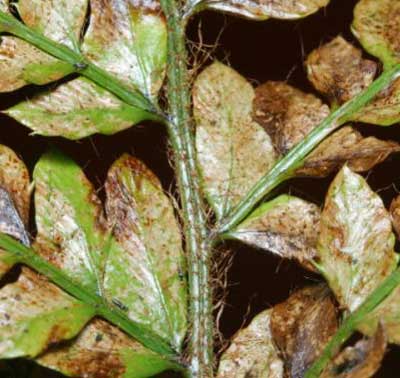Nutrition
Chances are
that if you have a greenhouse with a variety of plants a
majority of, if not all of them, would make a satisfactory meal
to the greenhouse thrips. This thrips will chow down on a vast
variety of plants, from crop plants to trees, to gardening
plants to weeds specifically eating the leaves and foliage of
the host plant. However it tends to pick out plants that are
water stressed that have harder leaves and are non-herbaceous
(University of California, 2009). Some specific victims of
greenhouse thrips attacks include azalea, begonia, croton,
cyclamen, ferns, fuschia, grape vines, orchids, palm, and rose
plants (North Carolina State University). Interestingly enough
the greenhouse thrips, in relevance to its name, likes to reside
to eating plants that flourish in a greenhouse environment or
hot tropical areas. It also prefers to eat in the shade under
the leaves of the plant (University of California 2009).
Here you can find a short list of some of the specific plant
species that are targeted by the greenhouse thrips. In
order to feed on the plant they use specialized mouth parts to
scrap off the epidermal layer of the host plant, getting to
inner cell contents that provide them with the proper nutrition
(Bain et al., 2009). This however can be very detrimental to the
plant itself as in most cases the host plants leaves tend to
turn a silvery bleached color where feeding has occurred and if
damage is bad enough the leaf will turn a brownish color, dry
out and fall off, along with any fruit close to the infected
area (North Carolina State University). Hard dark spots will
also freckle the surface of the leaves due to excrement dropped
by the greenhouse thrips (Bain et al., 2009). You may want to
visit
here for more information on the damage caused by
Heliothrips haemorrhoidalis (Bouche).
plants that flourish in a greenhouse environment or
hot tropical areas. It also prefers to eat in the shade under
the leaves of the plant (University of California 2009).
Here you can find a short list of some of the specific plant
species that are targeted by the greenhouse thrips. In
order to feed on the plant they use specialized mouth parts to
scrap off the epidermal layer of the host plant, getting to
inner cell contents that provide them with the proper nutrition
(Bain et al., 2009). This however can be very detrimental to the
plant itself as in most cases the host plants leaves tend to
turn a silvery bleached color where feeding has occurred and if
damage is bad enough the leaf will turn a brownish color, dry
out and fall off, along with any fruit close to the infected
area (North Carolina State University). Hard dark spots will
also freckle the surface of the leaves due to excrement dropped
by the greenhouse thrips (Bain et al., 2009). You may want to
visit
here for more information on the damage caused by
Heliothrips haemorrhoidalis (Bouche).
